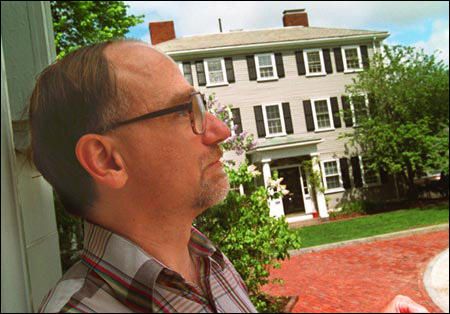The Big Picture:
Christopher Lenney: Sightseeker

Photo by Rose Lincoln
Christopher Lenney can tell you what Unitarianism has to do with candlepin bowling, how Maine’s “Great-Big Line” is neither great nor big, and why the Christ Church rectory on Garden Street and the Buckingham House in Radcliffe Yard have architectural offspring in Lexington and Bedford but not Nantucket or Plymouth.
Lenney’s distinctive knowledge comes not from his position at Lamont Library, where he has worked for 25 years, but from the extracurricular activity that’s kept him busy for over a decade. He’s been roaming the region’s backroads and combing the stacks of Widener and Loeb Design libraries to research his first book, “Sightseeking: Clues to the Landscape History of New England” (University Press of New England, 2003).
In “Sightseeking,” Lenney connects cultural artifacts – roads, place names, gravestones, houses, boundaries, and town plans – with regional patterns of speech, migration, religion, or even bowling. With hand-drawn maps and a wide sweep of research that extends to Colonial times, Lenney layers the region’s geography with its human influences to offer a new lens through which to view New England.
“Landscape is a cultural artifact,” says Lenney, a lifelong New Englander and avid explorer of the region’s landscape. “Because speech or dialect is also a cultural artifact, and New England dialect areas have been mapped since the 1930s, it is possible to relate landscape cultural features with dialect areas.”
Lenney offers up an architectural example, the twin rearwall chimney house, to illustrate his point. Popular in the Boston area during the Federal period, this style of house (exemplified in Cambridge by the Christ Church rectory [above], Buckingham House, and the Dexter Pratt House, now the Hi-Rise Bakery on Brattle Street) spread to the north and northwest but not the south. Its popularity, says Lenney, followed migration and speech patterns from what he calls the Massachusetts Bay hearth, which held Boston as its cultural center.
Lenney charts religion and bowling – “the sacred and the profane,” he says – along similar patterns. Unitarianism, candlepin bowling, and calling carbonated drinks “tonic” entrenched themselves in Boston and its hinterlands while Episcopalianism and duckpin bowling spread from the region’s other hearth, the Connecticut River Valley, to dominate Connecticut and western Massachusetts.
“Sightseeking” reflects Lenney’s love of the New England landscape and his abiding curiosity for facts that might otherwise go forgotten. He wrote the book, he says, as much to record his own observations and teach himself as to share it with others.
“I thought if I was going to take the time and effort to delve into this, I ought to leave some written record of it, if only so no one else would bother if it proved fruitless, or so that I could share it with others if it proved fruitful,” he says.
He hopes that by aggregating, naming, and connecting cultural artifacts, he’s provided would-be sightseekers with new insight into the region’s vanishing history.
“Once a house is built, it’s always there,” he says. “The landscape endures where the people who created it and the culture that they shared may no longer be noticeable.”




